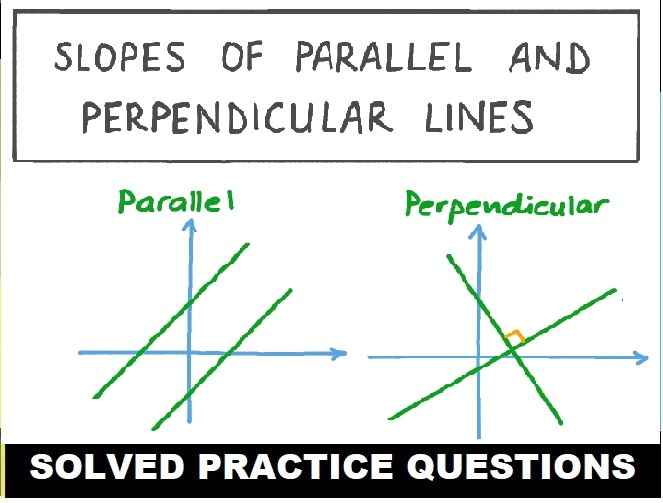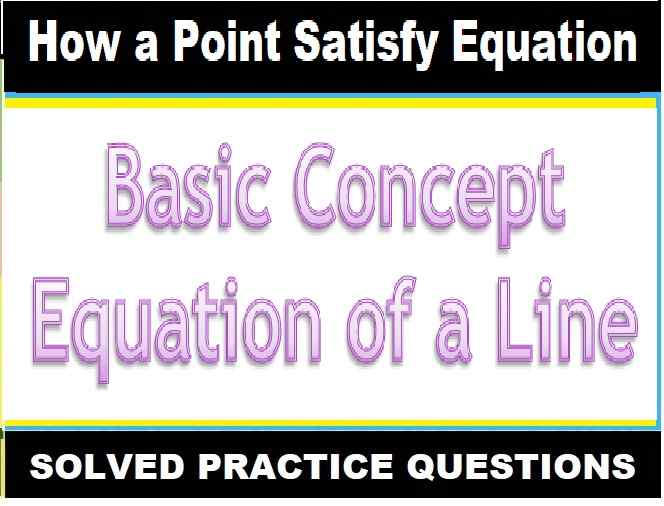Doppler Effect Numerical Class-11 Nootan ISC Physics Solutions Ch-30. Step by step solutions of Kumar and Mittal Physics of Nageen Prakashan as council latest prescribe guideline for upcoming exam. Visit official Website CISCE for detail information about ISC Board Class-11 Physics.
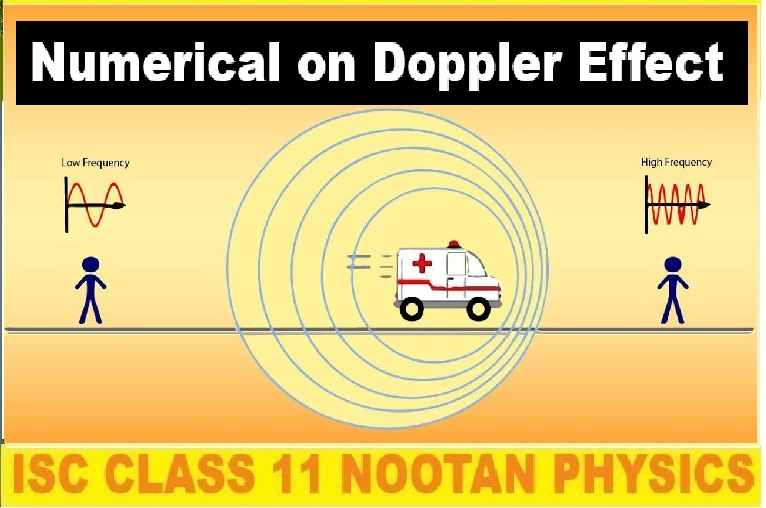
Doppler Effect Numerical Class-11 Nootan ISC Physics Solutions Ch-30
| Board | ISC |
| Class | 11 |
| Subject | Physics |
| Book | Nootan |
| Chapter-30 | Doppler Effect |
| Topics | Numericals on Doppler Effect |
| Academic Session | 2025-2026 |
Numericals on Doppler Effect
Class-11 Nootan ISC Physics Solutions Ch-30 Solutions of Kumar and Mittal Physics of Nageen Prakashan
Q-1: A sound-source is emitting waves of λ = 40 cm in air. If this source moves towards east with the speed 1/4 th to that of sound velocity then what will be the value of λ of the waves produced by it in the same direction and in the opposite direction?
Ans-
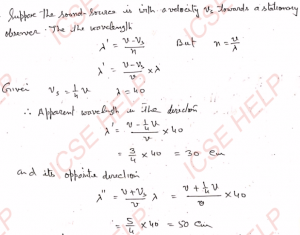
Q-2: An engine is approaching a railway station at 5 m s^-1 speed while sounding a whistle of 600 Hz frequency. What will be the frequency of the whistle as heard by an observer standing on the platform? Speed of sound is 340 m s^-1.
Ans-

Q-3: A source of sound is approaching a stationary listener with a speed of 166 m s^-1. The listener hears a sound whose apparent frequency is twice the real frequency. Find the speed of sound waves.
Ans-
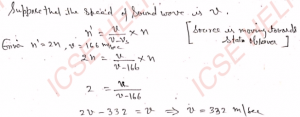
Q-4: If to a stationary observer the apparent frequency of a moving source of sound appears 5/4 of its real frequency, then find the speed of the source and its direction of motion.
Ans-
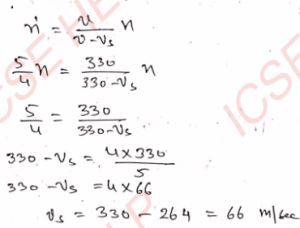
Q-5: A source of sound moving towards a stationary observer with a certain velocity passes him with the same velocity. The ratio of the apparent frequencies when the source is moving towards the observer and when moving away from the observer is 7/5. Find the velocity of the source of sound.
Ans-

Q-6: A whistling engine is approaching a stationary observer with a velocity of 110 m s^-1. Find the ratio of the apparent frequency of the whistle when the engine is going towards the observer to the frequency when the engine is going away from the observer.
Ans-
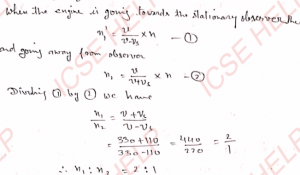
Q-7: A train is moving towards a stationary observer with a speed of 30 m s^-1. The frequency of its whistle appears to be 600 Hz to the . If the train were moving away from the observer with the same speed, then what frequency of the whistle would have been listened?
Ans-
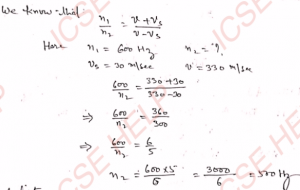
Q-8: A listener is approaching towards a stationary source of sound of frequency 90 Hz with speed 33 m s^-1. Determine the frequency heard by the listener.
Ans-

Q-9: With what velocity should an observer go away from a stationary source of sound so that the frequency of the sound as heard by him be half the actual frequency?
Ans-
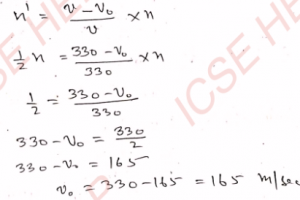
Q-10: With what velocity should an observer move towards a stationary source so that the apparent frequency is double of the actual frequency ? Velocity of sound in air is 350 m s^-1.
Ans-
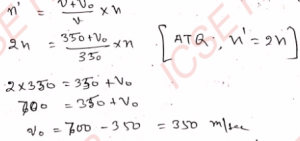
Q-11: With what velocity should a source of sound travel towards a stationary observer so that the apparent frequency may be double of the actual frequency? Velocity of sound is 340 m s^-1.
Ans-
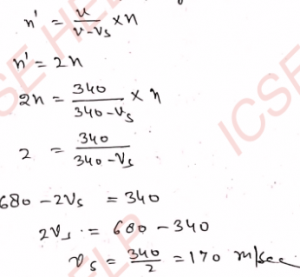
Q-12: Two trains are approaching each other with the speeds of 72 km h^-1. The frequency of the whistle of one train as heard by a passenger in the other train is 700 Hz. Find: (i) the real frequency of the whistle and (ii) the frequency of the whistle heard by the passenger when the trains have crossed each other.
Ans-
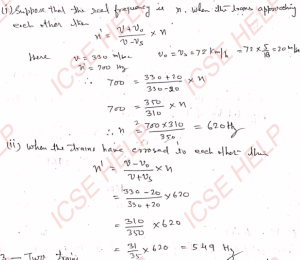
Q-13: Two trains, both at 108 km h^-1 speed, cross each other. One of the trains whistles whose frequency is 750 Hz. What frequency will be heard by a passenger in the other train (i) before crossing, (ii) after crossing?
Ans-
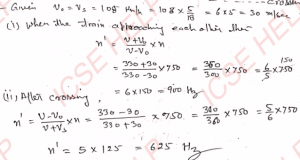
Q-14: A whistling engine, whose frequency is 1000 Hz, is going away from an observer towards a hill with a speed of 17 m s^-1. What will be the frequency of the sound heard directly from the engine and the frequency of the sound reflected from the hill as heard by the observer?
Ans-
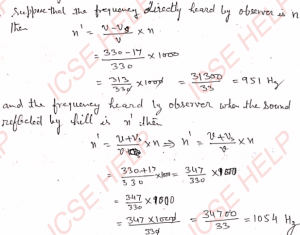
Q-15: A siren which is emitting sound of frequency 1000 Hz, is going away from a stationary listener towards a wall with a speed of 10 m s^-1. (a) What is the frequency of sound heard directly from the siren ? (b) What is the frequency of sound heard after reflection from the wall? (c) What is the beat-frequency heard by the listener? (d) What, if the listener is between the siren -1 and the wall? Speed of sound in air = 330 m s^-1.
Ans-

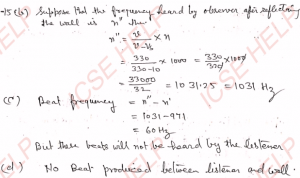
Q-16: A whistling engine, whose frequency is 1240 Hz, is going towards a hill with a speed of 72 km h^-1. The driver of the engine hears an echo of the whistle. Find the frequency of the echo as heard by him.
Ans-

Q-17: A table is revolving about its axis at a rate of 5 revolutions per second. A sound-source (frequency 1000 Hz) is fixed in the table at a distance of 0.70 m from the axis. Calculate the maximum and minimum frequencies as heard by a listener standing at a distance from the table. The speed of sound at the room temperature is 352 m s^-1.
Ans-
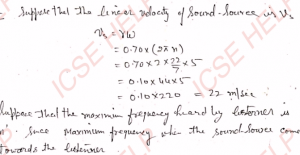
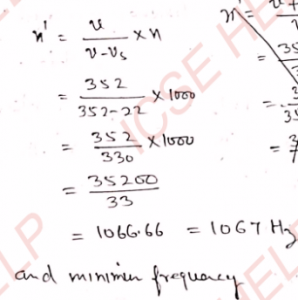

— : End of Doppler Effect Numerical Class-11 Nootan ISC Physics Solutions Ch-30 solutions –
Return to : – – Nootan Solutions for ISC Physics Class-11
Thanks
Please share with your friends
